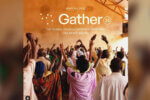I love Christmas music. I love it so much that I start listening to my playlist the last week of October—because 1) I’m not a fan of Halloween, and 2) I want to spread holiday cheer for as long as possible. I have almost every genre of music in my collection—including 1940s Big Band, 1950s rock, Bing Crosby, country and Kirk Franklin, along with more contemporary tracks.
Radio stations play “holiday” music 24 hours a day, but many of these songs don’t even mention the reason for the season. We hear lyrics about snow, icicles and winter weather (even though Christmas is hot in most parts of the world), overcoats, shopping, sleighs, Santa Claus, reindeer, toys, holly, elves, bells, chipmunks and pumpkin pie.
I don’t mind the secular songs. One of my favorite Christmas albums is Nat King Cole’s The Christmas Song from 1963. But while it features classics like “Jingle Bells,” “Deck the Halls” and the famous title track about chestnuts roasting on an open fire, it also offers 10 carols that are unapologetically Christian. (Nat King Cole’s father was a Baptist minister, and the singer’s faith obviously affected his career.)
There was a time in our history when Christmas music was mostly spiritual. People actually sat around fireplaces, gathered on street corners or met in churches to sing carols that made overt references to the birth of Jesus. I love those songs the most, and I encourage you to enrich your Christmas with the classic music that has been passed down for many years. Here are some of the “greatest hits” that capture the essence of the season:
“O Holy Night.” This stirring anthem isn’t easy to sing unless you’re a professionally trained tenor—and that’s why I prefer listening to this version by Josh Groban. It gives me goosebumps every time I hear it. Composed in 1847, it glorifies the incarnation of Christ and contains a powerful, prophetic denouncement of slavery: “Chains shall He break, for the slave is our brother/ and in His name all oppression shall cease.” A 1906 version of this carol was the first song ever played on the radio.
“O Come, O Come Emmanuel.” Originally written in Latin in the 12th century, this majestic carol reminds us how the Jews yearned for the coming of the Messiah: “O come, Thou Rod of Jesse free/ Thine own from Satan’s tyranny/ from depths of hell Thy people save/ and give them victory o’er the grave.” Few hymns are as rich in biblical imagery. Irish singer Enya‘s version is one of the best because it maintains the medieval style.
“The First Noel.” Christmas carols were originally used as lessons to narrate the story of Christ’s birth. This song describes the shepherds, angels, wise men and the Christ child in masterful poetry—and reminds us that the Savior “hath made heaven and earth of nought/ and with His blood mankind hath bought.” (The word Noel, or “Nowell” in 18th-century English, means Christmas.) Here is Ella Fitzgerald‘s take on this classic.
“It Came Upon a Midnight Clear.” Penned in 1849, this carol had deep meaning in the United States at a time when tensions were mounting between North and South. It emphasizes that the message of the angels at Christ’s birth was about peace and reconciliation: “And man, at war with man, hears not/ the love-song which they bring/ O hush the noise, ye men of strife/ and hear the angels sing.” Johnny Mathis‘ 1958 version is amazing.
“O Little Town of Bethlehem.” An Episcopal priest from Philadelphia wrote this carol after a pilgrimage to the Holy Land in 1865. It reminds us of how God used such an insignificant place to stage the miracle of redemption. (“How silently, how silently, the wondrous gift is given!”) Nat King Cole recorded one of the best renditions of this song.
“Joy to the World”: Penned by Isaac Watts in 1719, it was not intended to be a Christmas carol. Yet today it is the most widely published Christmas hymn. It is based on Psalm 98 and celebrates Christ’s victory through His Second Coming with powerful words like this: “He rules the world with truth and grace/ and makes the nations prove the glories of His righteousness.” There have been many pop recordings of this carol (I love Whitney Houston‘s gospel rendition), but the one by Andy Williams is a personal favorite.
“Hark the Herald Angels Sing!” Charles Wesley, founder of Methodism, wrote this song in 1739, but it had a somber melody. The livelier version we sing was composed in 1840. This hymn packs a theological punch in every line, with references to the incarnation, the Trinity and regeneration: “Christ by highest heav’n adored/ Christ the everlasting Lord!/ Late in time behold Him come; offspring of a virgin’s womb.” Amy Grant released a perfect version of this carol way back in 1983.
“Sweet Little Jesus Boy.” Written in the style of old Negro spirituals, this song captures the essence of Christmas from the perspective of distant observers—and reminds us that Christmas is not about white European culture. Mahalia Jackson‘s soulful rendition is one of the most authentic.
“What Child Is This?” William Chatterton Dix wrote this song in 1865 after a bout with depression. It was later set to the famous 16th-century English melody, “Greensleeves.” Rather than retelling the Christmas story, it calls us to participate in it: “So bring Him incense, gold, and myrrh/ Come, peasant, king, to own Him/ the King of kings salvation brings/ Let loving hearts enthrone Him.” Michael W. Smith did a moving rendition of this song with Martina McBride.
“Angels We Have Heard on High.” This hymn was translated into English in 1862 from a French carol, and is best known for its Latin refrain, “Gloria in excelsis Deo” (“Glory to God in the highest”). My favorite version of this carol is a rousing black gospel rendition by Sandra Crouch, sister of Andrae Crouch.
I encourage you not to rush through the holidays without listening to the songs that give Christmas its true meaning.
J. Lee Grady is an author, award-winning journalist and ordained minister. He served as a news writer and magazine editor for many years before launching into full-time ministry.
Lee is the author of six books, including 10 Lies the Church Tells Women, 10 Lies Men Believe and Fearless Daughters of the Bible. His years at Charisma magazine also gave him a unique perspective of the Spirit-filled church and led him to write The Holy Spirit Is Not for Sale and Set My Heart on Fire, which is a Bible study on the work of the Holy Spirit.








Leave a Comment
You must be logged in to post a comment.